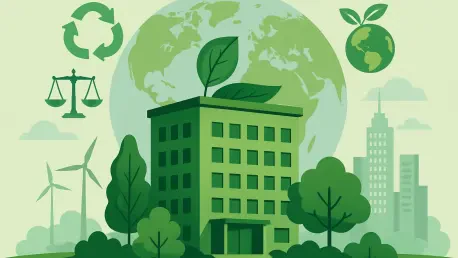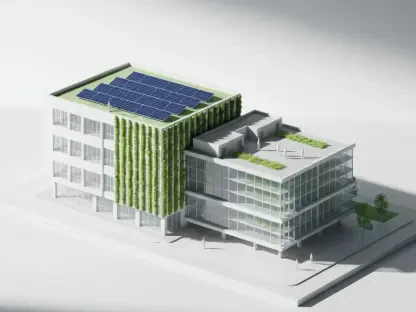The real estate industry across the globe is experiencing a profound transformation as green building policies emerge as a cornerstone in the battle against climate change, pushing for sustainability in ways that were unimaginable just a decade ago. Governments and local authorities are no longer just suggesting eco-friendly practices; they are enforcing stringent regulations aimed at decarbonization, energy efficiency, and climate resilience within the built environment. As one of the largest contributors to global carbon emissions, the sector finds itself at the heart of this environmental overhaul, compelled to rethink how buildings are designed, constructed, and managed. These policies are not mere formalities but powerful mandates that dictate the future of urban development. This shift is creating both unprecedented challenges and unique opportunities for stakeholders, from developers to investors, as they navigate a rapidly changing landscape. With insights drawn from global trends and industry initiatives, the following exploration delves into how these sustainability-focused regulations are redefining the real estate market on an international scale.
From Guidelines to Mandates
The evolution of green building policies marks a significant pivot from voluntary guidelines to enforceable mandates that directly influence real estate practices. No longer are jurisdictions satisfied with collecting data or encouraging best practices; the emphasis has shifted to achieving measurable outcomes at the asset level. This means buildings must now meet specific targets like net-zero carbon emissions, integrate fossil fuel-free heating systems, and incorporate energy efficiency upgrades as non-negotiable standards. In regions like the United States, cities such as Boston have rolled out rigorous zoning codes mandating net-zero carbon for new projects, setting a precedent for others to follow. Similarly, across the Atlantic, Germany is working toward a complete phase-out of fossil fuels in heating systems by 2045, aligning with broader sustainability goals. This global movement underscores a commitment to tangible environmental impact, fundamentally altering how real estate projects are conceptualized and brought to fruition, with a clear focus on reducing carbon footprints right from the foundation.
Beyond carbon reduction, these mandates are expanding to encompass a wider array of sustainability measures that reshape building functionality. Requirements now often include the installation of electric vehicle charging infrastructure to support cleaner transportation and climate adaptation measures to withstand extreme weather events. Such policies reflect a growing recognition that buildings must not only minimize environmental harm but also be prepared for future challenges posed by a changing climate. This dual focus on mitigation and adaptation is evident in various local initiatives, pushing developers to integrate resilience into their designs. For real estate stakeholders, this translates into a need for innovative approaches and technologies to meet diverse regulatory demands, often requiring significant investment and strategic planning. The pressure to comply with these evolving standards is reshaping project timelines and budgets, as the industry grapples with balancing compliance costs against the long-term benefits of sustainable building practices.
Navigating a Patchwork of Rules
One of the most daunting aspects of green building policies is the sheer diversity of regulations across different regions, creating a fragmented landscape that complicates compliance for the real estate sector. While the ultimate goal of decarbonization binds these efforts together, the methods, timelines, and enforcement mechanisms vary widely from one jurisdiction to another. In the Asia-Pacific region, for instance, Singapore has implemented mandatory energy audits for both new and existing structures, ensuring ongoing accountability. Meanwhile, the European Union is setting aggressive renovation targets for energy-inefficient buildings to meet stringent efficiency benchmarks. This lack of uniformity poses a significant challenge for companies managing portfolios across multiple countries, as they must tailor their strategies to align with local laws while maintaining operational coherence. The resulting complexity often delays projects and increases costs, as firms strive to stay compliant in a regulatory environment that feels like a moving target.
The implications of this fragmented regulatory framework extend beyond mere compliance, affecting investment decisions and long-term planning within the real estate industry. Companies operating internationally must allocate substantial resources to monitor and adapt to varying local policies, a task that can divert attention from core business activities. The uncertainty stemming from differing standards can also deter investors who seek predictable returns, as the risk of non-compliance penalties looms large. To address these challenges, many firms are turning to specialized consultants and legal experts to navigate the intricacies of regional regulations. However, the need for a more harmonized approach remains evident, as stakeholders advocate for standardized guidelines that could simplify adherence without compromising environmental ambitions. Until such consistency is achieved, the industry must remain agile, anticipating shifts in policy and adapting to diverse requirements across global markets.
Striking a Balance Between Goals and Growth
As green building policies intensify, governments face the intricate challenge of driving decarbonization while safeguarding economic vitality, a tension that deeply impacts the real estate sector. The ambition to reduce emissions through strict regulations often clashes with the practical realities of business operations, leaving industry players in a precarious position. Uncertainties surrounding corporate-level Environmental, Social, and Governance (ESG) reporting standards further complicate the landscape, as debates over climate disclosure rules in the United States and simplification efforts in the European Union create hesitation among businesses. Without clear, consistent frameworks, companies struggle to align their strategies with regulatory expectations, risking both financial penalties and reputational damage. This dynamic underscores the urgent need for policies that are not only environmentally ambitious but also feasible within the constraints of economic realities, ensuring that sustainability does not come at the expense of growth.
At the local level, however, the momentum for sustainability shows no signs of slowing, with cities and regions often taking the lead in implementing bold green initiatives. These localized efforts frequently outpace national or international agreements, placing additional pressure on real estate stakeholders to adapt quickly to stringent mandates. For instance, urban centers are pioneering fossil fuel bans and net-zero building codes, compelling developers to rethink traditional construction methods. While such initiatives are crucial for environmental progress, they can strain budgets and timelines, particularly for smaller firms with limited resources. The industry finds itself at a crossroads, advocating for regulatory clarity and support mechanisms that can ease the transition to greener practices. Bridging the gap between governmental ambition and economic practicality remains a critical focus, as stakeholders seek collaborative solutions to ensure that environmental goals enhance rather than hinder market stability.
Empowering Compliance Through Innovation
In the face of a complex and ever-evolving regulatory environment, industry-led tools and initiatives are emerging as vital resources for real estate professionals striving to meet green building standards. A prime example is the Urban Land Institute (ULI) Greenprint’s Global Green Building Policy Dashboard, which meticulously tracks regulations across 81 jurisdictions worldwide. This platform provides a user-friendly visual map, allowing practitioners to filter by region and regulation type, thereby reducing the time spent on research and enabling a sharper focus on implementation. Such tools are indispensable in helping stakeholders stay abreast of local requirements without becoming overwhelmed by the volume of information. By streamlining access to critical data, these resources empower companies to allocate their efforts toward actionable sustainability measures, transforming regulatory challenges into opportunities for meaningful environmental impact.
Equally significant are collaborative efforts aimed at standardizing sustainability metrics, which play a crucial role in simplifying compliance across diverse markets. Initiatives like Aligning Real Estate Sustainability Indicators (ARESI) are working to harmonize key performance indicators within Europe’s legislative framework, cutting through the ambiguity that often hinders progress. By establishing clear benchmarks, such programs facilitate the allocation of capital toward climate transition projects, encouraging investment in sustainable real estate. These efforts highlight a growing consensus within the industry on the importance of uniformity, as fragmented regulations can stifle innovation and delay critical projects. As more organizations and policymakers engage in these harmonization initiatives, the real estate sector gains the clarity needed to navigate green policies effectively. This collaborative spirit not only eases the compliance burden but also fosters a culture of innovation, positioning the industry to lead in the global push for a sustainable built environment.
Reflecting on a Sustainable Path Forward
Looking back, the journey of green building policies reveals a dynamic interplay of ambition and adaptation that has redefined the real estate landscape over recent years. Governments and local authorities worldwide have demonstrated a resolute commitment to sustainability, enforcing regulations that compelled the industry to prioritize decarbonization and resilience. Despite the hurdles posed by a fragmented regulatory framework, the sector has shown remarkable resilience, leveraging tools like the ULI Greenprint dashboard to navigate complexities. Collaborative efforts such as ARESI have paved the way for standardized metrics, easing compliance and fostering investment in eco-friendly projects. Reflecting on these strides, it becomes evident that proactive engagement between stakeholders and policymakers has been instrumental in balancing environmental goals with economic viability, setting a precedent for future progress.
Moving ahead, the real estate industry must build on these foundations by advocating for global consistency in green building policies to simplify compliance and encourage innovation. Investing in advanced technologies and sustainable design practices will be crucial to meeting evolving standards without compromising profitability. Additionally, fostering ongoing dialogue with regulators can help shape frameworks that support both environmental and business objectives. By continuing to embrace industry-led tools and partnerships, stakeholders can transform regulatory challenges into catalysts for long-term growth. The path forward lies in a collective commitment to sustainability, ensuring that the built environment not only mitigates climate impact but also adapts to future uncertainties, securing a greener legacy for generations to come.









